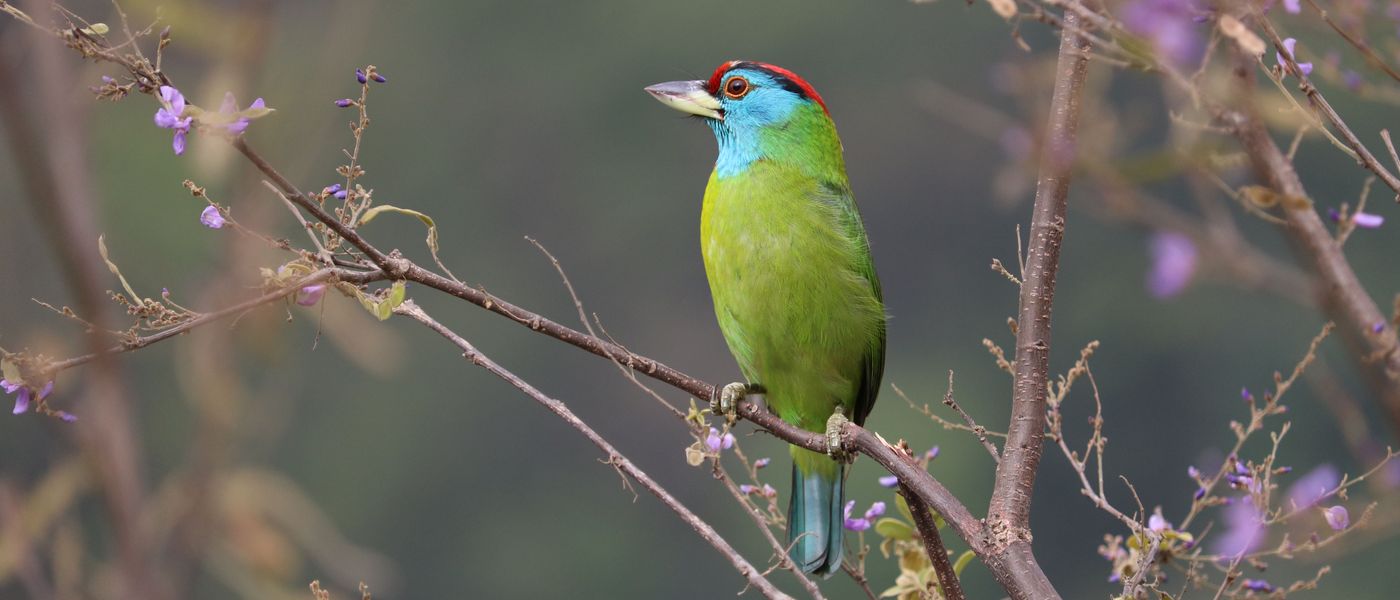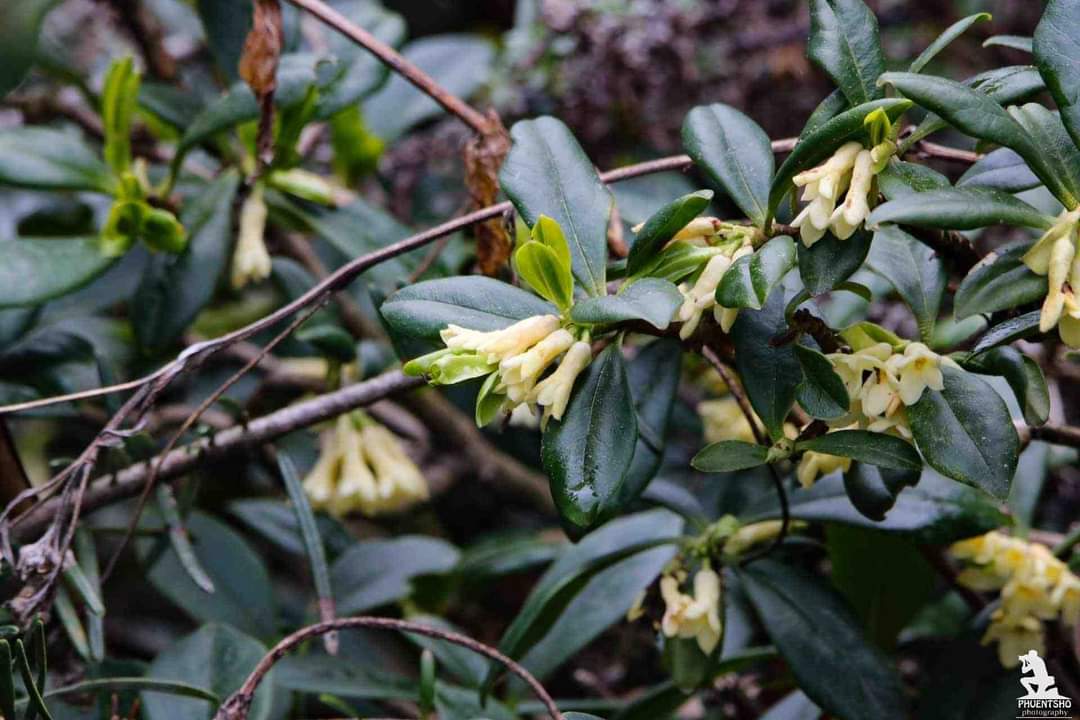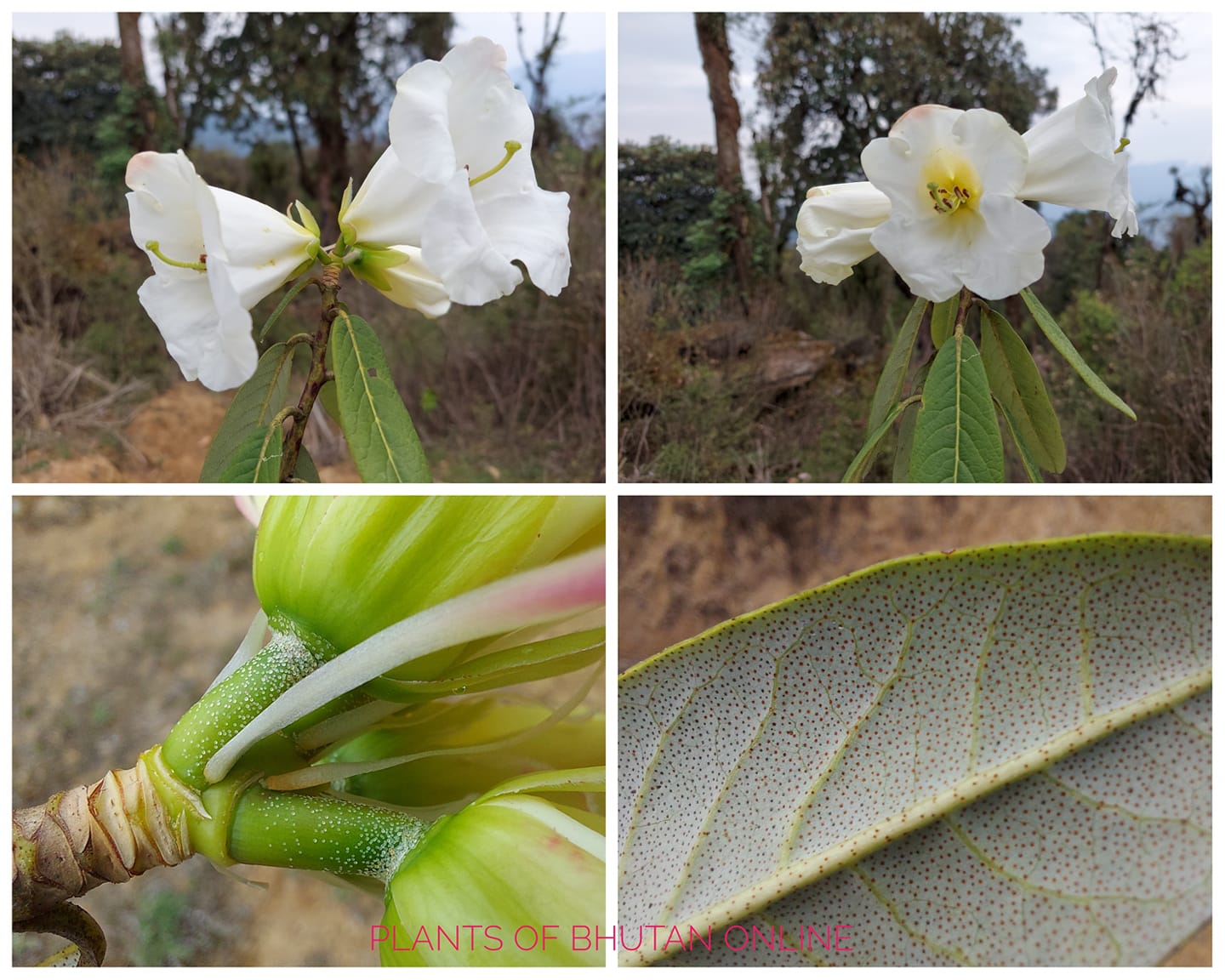- Details
- Written by Phuentsho
Summary
Daphne ludlowii D.G Long is a low multi-stemmed shrub first seen and collected around Phephe La in Bumthang on 21 May 1949 by Frank Ludlow, George Sherriff, and J.H. Hicks. Compared to the other four species of Daphnes found in Bhutan, it is much rarer and even considered to be endemic to Bhutan previously. However, it has also been seen in the Po Tsangpo region in the Tibetan Autonomous Region of China.
Taxonomic description
Low multi-stemmed, suckering, shrub 20-30cm; young shoots tomentose, becoming glabrous. Leaves not or loosely clustered towards branch ends, thinly coriaceous, oblanceolate, 3 - 6.5 x 1 - 2 cm, shortly acuminate to a narrow, retuse point, base attenuate, glabrous, margins weakly revolute; petioles 5 - 7 mm. Inflorescence a 10 - 25 flowered sessile terminal cluster, produced from scaly buds, scales oblong c 8mm long, acute with densely ciliate margins. Flowers not fragrant. Perianth tube 7 - 9 mm, densely hairy, pale to bright yellow; lobes ovate 4 - 5 x 1 - 3 mm, rounded.
-Description from the Flora of Bhutan
Habitat
Mixed Rhododendron, Hemlock, and Spruce forest between 3350 and 3580m.
- Details
- Written by Phuentsho

Rhododendron pogonophyllum Cowan & Davidian flowering in its natural habitat
The Flora of Bhutan describes a total of 46 species out of which 45 are known to be occurring in Bhutan. The book describes Rhododendron pogonophyllum Cowan & Davidian as a rare endemic plant to Bhutan. Subsequent publication of the book “Plants Endemic to Bhutan Himalaya '' by the National Biodiversity Centre, MoAF published in 2015 listed it as one of the endemic plant species found in the country with a herbarium specimen as an evidence. “Wild Rhododendrons of Bhutan'', a book by Rebecca Pradhan in 1999 has photos of the Rhododendrons found in Bhutan including R. pogonophyllum with descriptions of its flower, leaf, flowering time, habitat, altitude, distribution and with a remark stating as an endemic and rare plant species not seen since 1937, but without any picture. The book reports a total of 46 Rhododendron species in Bhutan.

The habitat of Rhododendron pogonophyllum at Kyitsugang in Dangchu, Wangdue Phodrang. The whitish specks visible on the cliff side of the mountain is the R. pogonophyllum.
R. pogonophyllum was first collected by George Sherriff, a Scottish plant collector on 7th June 1937 at Tang Chu in Wangdue Phodrang. His 1937 trip was mainly focused around the central Bhutanese mountains including the Black Mountains. He ventured out to explore the Pele La range which falls to the east of Dangchu which Sherriff wrote as Tangchu in his specimen locations. After a night halt at Trashidinkha in Dangchu, he climbed towards Kyitsugang which Sherriff wrote as Chizukang. On his second day, he found many interesting plants including Primulas and the Rhododendron pogonophyllum in particular under collection number 3216. Earlier the specimen collected was thought to be Rhododendron hypenanthum which is now considered as a subspecies of Rhododendron anthopogon. Later Cowan & Davidian described it as a new species using the specimen collected by Sherriff from this locality and the specimen currently resides at Royal Botanic Garden Edinburgh in UK with the catalogue number E00010309. Later in July Sheriff also collected the same Rhododendron species from Rinchen Chu (Chore) in central Bhutan on 13th July 1937. Currently, Chore is known as Khero to the locals, and the present day Nikachu was known as Rinchenchu. Chore=Khero and Chizukang=Kyitsugang lie on the same mountain range separating the Nikachu and the Dangchu watersheds. Khero[Chore] is located within an aerial radius of around 5 km from Kyitsugang [Chizukang].
With the help of David Long from the Royal Botanic Garden Edinburgh and Pam Eveleigh from the Primula World, the type locality was traced and a team from the National Herbarium and Royal Botanical Garden, Serbithang under NBC, MoAF made an expedition to the mountain east of Dangchu in June this year. During the expedition, the team was faced by incessant rainfall and footpath which was barely noticeable since the cow herders of the Ramno grazing area stopped taking their cattle to the grazing area last year. The team took shelter in the wooden huts of the cow herders from Dangchu and ascended through steep cliffs towards the Kyitsugang the next day. Despite the incessant rainfall and cold mountain winds, the team finally found the lovely and tiny Rhododendron pogonophyllum flowering beautifully and precariously on the rocks and rocky soils on open hillsides at Kyitsugang at an altitude of 4,452 metres above sea level. Kyitsugang is considered by the residents of Dangchu to be the abode of their deity Kyitsub. Rhododendron pogonophyllum which was recorded in 1937 is thus rediscovered after 84 years in Bhutan. The specimens collected will be deposited in the National Herbarium of Bhutan (THIM) which is the official botanical repository and reference centre of the country.

Closed up of the flowers of R. pogonophyllum
Rhododendron pogonophyllum Cowan & Davidian is a creeping subshrub which has similar flowers to that of Rhododendron anthopogon with small obovate leaves with rounded or retuse apex, rounded at base, and scaly leaf underside.
- Details
- Written by Phuentsho
Botanical name: Rhododendron campylocarpum Hook.f.
Description:
An aromatic shrub or a small tree to 6m tall. Branchlets are covered with stalked glands. Leaves ovate-elliptic, rounded or apiculate at apex; Shallowly cordate at base, whitish and glabrous beneath. Petioles have stalked glands. Flowers in racemes with 5-13 flowers in a single raceme. Pedicels bears stalked glands. Calyx is cup-shaped with 5 lobes. Corolla bell-shaped with 5 lobes, pale yellow in color, sometimes with a red basal blotch. Stamens 10. Ovary densely covered by stalked glands with the style glandular at base and glabrous above. Seed capsules strongly curved.
Habitat:
Hemlock, Fir/Rhododendron forests from 3050-4200m. Flowering: May-July Date & place of photography: May 2017 at Lamsela (Pass between Chendebji and Phobjikha)
- Details
- Written by Phuentsho
Rhododendron lindleyi T.Moore is usually epiphytic with shoots and petioles scaly, not bristly. Leaves elliptic, rounded at apex, pale beneath with conspicuous scattered red scales. Racemes 2-3 flowered. Pedicels scaly; calyx lobes with ciliate margins, otherwise glabrous. Corolla white with golden yellow at base within. Stamens 10; filaments pubescent in lower part. Ovary 5 celled.
Found in evergreen oak and Hemlock forests from 2100-2740m
Flowering: April-May
Subcategories
New records
New species records from Bhutan
© 2025 Bhutan Biodiversity Atlas
Copyright
All Rights Reserved. Bhutan Biodiversity Atlas holds copyright for all the materials and data available on this website and all other Web Applications and Mobile Apps developed and maintained by the Bhutan Biodiversity Atlas except for the images contributed by various photographers. Respective photographer hold copyright for images, as cited in the image caption.







